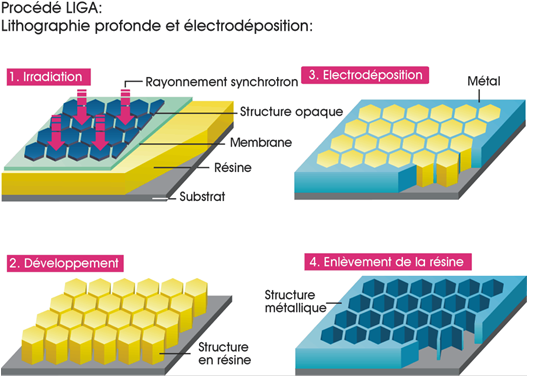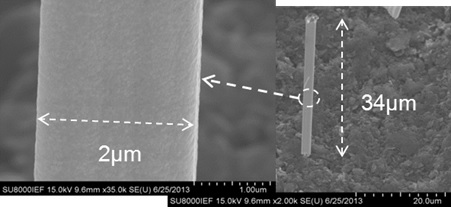Principles of the LIGA process:
In its first step, the LIGA process is merely an extension of microlithography techniques in the sense that the 2D image of a mask is transferred to a resin (polymer) sensitive to radiation. The difference arises from the fact that what is now under consideration are thick resins (up to a millimetre or more) deposited on a metallic substrate. This implies that the light source cannot originate from a UV lamp (classical lithography case) nor from a synchrotron source of soft X-rays (as used for nanolithography), but rather from a high-flux, hard X-ray synchrotron radiation source emitting radiation with a wavelength of a few tenths of a nanometre. Due to the extreme natural collimation of a synchrotron, dimensional tolerances of a fraction of a micrometre are possible. This property is one of the key advantages of LIGA. Of course the mask technology is also specialised.
The second step is to develop the latent image transferred to the volume of the resin by means of selective chemical dissolution between irradiated and blanked areas. This step is achieved by the electrodeposition of a metal, in the polymer mould, which is generally left to overflow to obtain a metallic countermould.
At this stage, ‘a tool’ has been created from which it will be possible “endlessly” reproduce the microstructures that it contains, either by stamping or by injection (of another metal or a polymer). This third LIGA step will necessarily be the resource of the business involved in the application that wishes to commercialise it.
Numerous variants exist from the second step of the process presenting another benefit of LIGA, which provides access to the fabrication, at medium or large scale, of polymer, metal or alloy microstructures, even of ceramic microstructures.
LIGA steps:

Advantages of the process:
- very high dimensional accuracy of the parts due to extreme collimation of the synchrotron beam
- possibility of fabrication of medium or large scale polymer, metal or alloy microstructures, even ceramic microstructures.
- multiple station configurations and beam modes adapted to varying requirements
- stability of the X-ray beam intensity provides control of experimental conditions and avoids the requirement for corrections during exposure
Our experts:
Fayçal Bouamrane, researcher at UMR CNRS-THALES and associate researcher on the METROLOGY line for the LIGA station
Pascal Mercere, manager of the METROLOGY beamline
Paulo da Silva, Assistant engineer of the METROLOGY beamline
More information :
- Histoire du procédé, configuration et modes de fonctionnement actuel à SOLEIL
- Exemples de réalisations :
More information : Céline LORY, tel : 01 69 35 91 40, celine.lory@synchrotron-soleil.fr


